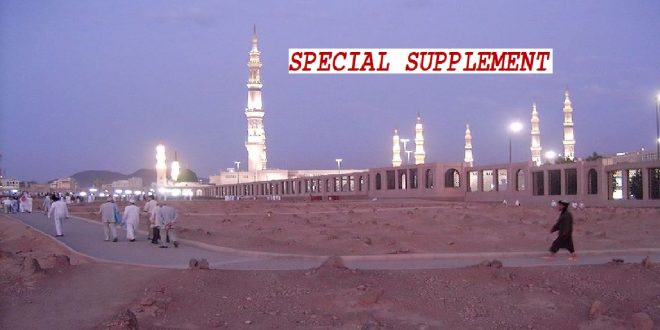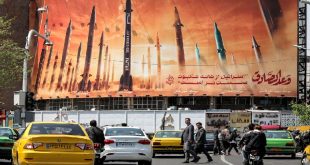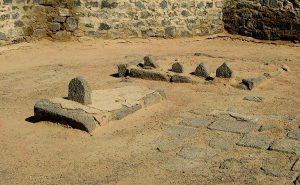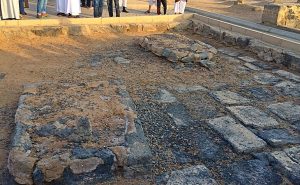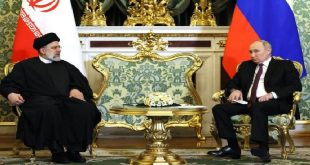30/31-05-2020
By Syed Jaffer Abbas Jafri
MELBOURNE/ JANNAT-AL-BAQI (MADINA)
Where Jannat-al-Baqi is situated?
Jannat-ul-Baqi is the famous cemetery located right across the Masjid-al-Nabawi (The mosque of Prophet Muhammad Peace Be Upon Him/PBUH) in the Holy City of Madina, Kingdom of Saudi Arabia (KSA). Children, wives and immediate relatives of Prophet (PBUH) are buried in this cemetery. They are; Ibrahim (Alaihis-Salam/AS) – Son of Prophet Mohammad (PBUH), Fatima Zehra (Salamullah-e-Alaiha/SA) – Daughter of Prophet Mohammad (PBUH), Imam Hassan al Mujtaba (AS) – Grandson of Prophet Mohammad (PBUH), Imam Ali Ibnul Hussain (AS) – Great Grandson of Prophet Mohammad (PBUH), Imam Muhammad Baqar (AS) – Great Grandson of Prophet Mohammad (PBUH), Imam Jaffer Sadiq (AS) – Great Grandson of Prophet Mohammad (PBUH), Abbas Ibn Abd al-Muttalib (AS) – Uncle of Prophet Mohammad (PBUH) and many other family members, near and dear ones.
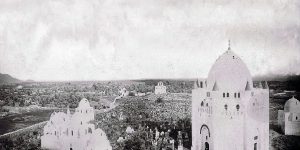 Jannat-ul-Baqi was razed to the ground by the government of Saudi Arabia leaving behind no signs of any grave or tomb.
Jannat-ul-Baqi was razed to the ground by the government of Saudi Arabia leaving behind no signs of any grave or tomb.
When it was demolished?
On 8th Shawwal, Wednesday, in the year 1345 AH (April 21, 1925), mausoleums in Jannatul-al-Baqi (Madina, Kingdom of Saudi Arabia/ KSA) were demolished by King Ibn Saud.
In the same year (1925), he also demolished the tombs of holy personages at Jannat al-Mualla (Makkah) where the Holy Prophet (s)’s mother, wife, grandfather and other ancestors are buried.
Destruction of sacred sites in Hijaz by the Saudi Wahhabis continues even today. According to some scholars what is happening in Hijaz is actually a conspiracy plotted by the Jews against Islam, under the guise of Tawheed. The idea is to eradicate the Islamic legacy and heritage and to systematically remove all its vestiges so that in the days to come, Muslims will have no affiliation with their religious history.
Al Baqi cemetery, an oldest and one of the two most important Islamic graveyards located in Medina, in current-day Saudi Arabia, was demolished in 1806 and, following reconstruction in the mid-19th century, was destroyed again in 1925 or 1926. An alliance of the House of Saud, and the followers of the Wahabi movement known as the Emirate of Diriyah, carried out the first demolition. The Sultanate of Nejd, also ruled by the House of Saud and followers of Wahhabism carried out the second. In both cases, the actors were motivated by the Wahhabi interpretation of Islam, which prohibits the building of monuments on graves.
Baqi al-Gharqad (Arabic: بقیع الغرقد, “the field of thorny trees”), also known as Jannat al-Baqi (Arabic: جنت البقیع, “garden of tree stumps”), was used as a cemetery before the advent of Islam. The most famous person buried at al-Baqi during the lifetime of the Prophet of Islam, Muhammad, was his infant son Ibrahim. Many narrations attest that the Prophet visited this cemetery regularly to pray for God’s forgiveness for those buried there.
It gained further attention after the first companion of Muhammad, ‘Uthman ibn Maz’un (or As’ad ibn Zurarah) was buried there in 625. Four Imamah Imams: Hasan ibn Ali, Ali ibn Husayn, Muhammad al-Baqir, and Jafar al-Sadiq were also buried there making it an important location for Shia Muslims. Historical records show that there were domes, cupolas, and mausoleums in Jannat al-Baqi before the 20th century; today it is a bare land without any buildings.
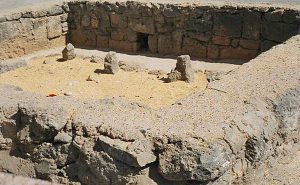 An alliance between Muhammad ibn Abd al-Wahhab and Muhammad ibn Saud led to the formation of the first Saudi State (also known as the Emirate of Diriyah), challenging the authority of the Ottoman Empire. Most of the Najd was under Ibn Saud’s control by the time Muhammad bin Saud died in 1765. By 1806, the Hijaz, including Mecca and Medina, was under the control of the Saudis. The expansion of the Wahhabi movement came at the expense of the Ottoman empires’ losing control over Islam’s holy places. Consequently, the Ottoman Empire sent armies and defeated the first Saudi state in the Ottoman-Wahhabi War (1811–1818). Years later in 1924–1925, the Saud clan regained control over Hijaz and the Kingdom of Hejaz and Nejd was formed under Abdul Aziz ibn Saud’s rule.
An alliance between Muhammad ibn Abd al-Wahhab and Muhammad ibn Saud led to the formation of the first Saudi State (also known as the Emirate of Diriyah), challenging the authority of the Ottoman Empire. Most of the Najd was under Ibn Saud’s control by the time Muhammad bin Saud died in 1765. By 1806, the Hijaz, including Mecca and Medina, was under the control of the Saudis. The expansion of the Wahhabi movement came at the expense of the Ottoman empires’ losing control over Islam’s holy places. Consequently, the Ottoman Empire sent armies and defeated the first Saudi state in the Ottoman-Wahhabi War (1811–1818). Years later in 1924–1925, the Saud clan regained control over Hijaz and the Kingdom of Hejaz and Nejd was formed under Abdul Aziz ibn Saud’s rule.
Wahhabis tried to carry out the demolition within a legal religious context since they regarded the shrines as “idolatrous” and believed that marking graves is Bid’a (heresy), based on their interpretation of Quranic verses regarding graves and shrines. They drew from the story of the golden calf found in the Qur’an where Israelites manufactured idols and prayed to them causing God to become angry. Some Muslims see the story as a “blanket prohibition” against the worship of images and shrines.
On the other hand, Shia scholars used a number of different verses and traditions to support the practice of building shrines over the graves of Islamic saints. According to Shia scholar Mohammad Jaffar Tabasi, the graves of Shia Imams buried in al-Baqi had been revered for hundreds of years and none of the Sunni scholars (Ulamas) regarded the shrines as innovation. Weeks before the second demolition, at the request of Ibn Bulayhid, a group of fifteen scholars from Medina unanimously issued a fatwa (an Islamic legal ruling) condemning the making of mausoleums around the graves. According to Islamic studies scholar Adeel Mohammadi, the Wahhabis’ destruction of al-Baqi also had political roots. The leader of a Muslim community is responsible for enjoining good and forbidding wrong (Amar bil maroof wa nahi anil munkir) and he can fulfil this responsibility only by having political power. The destruction by the Wahhabis was a political act to establish Najdi authority in the Hijaz, consisted of the religious authority of Najd, Wahhabi scholars, and the political authority of the Saudi family. Mohammadi argues that by the destruction, “Saudi authorities sought to broadcast their newly acquired political power”. It has been suggested that the veneration of Islamic shrines represented the desire for a united theological approach to God and a political approach to land. Wahhabism also views the destruction of the site as justified on theological and political principles. According to Mohammadi, the destruction could be carried out with the purpose of indicating victory over Shia, as al-Baqi is the burial place of a number of Shia Imams and members of Ahl al-Bayt (“People of the House”) – Muhammad’s family.
Literally “al-Baqi” means a tree garden. It is also known as “Jannat al-Baqi” due to its sanctity, since in it are buried many of our Prophet’s immediate relatives and companions.
The first companion buried in al-Baqi was Uthman Madhoon who died on the 3rd of Sha’ban in the 3rd year of Hijrah. The Prophet (s) ordered certain trees to be felled, and in its midst, he buried his dear companion, placing two stones over the grave.
On the following years, the Prophet’s son Ibrahim, who died in infancy and over whom the Prophet (s) wept bitterly, was also buried there. The people of Madina then began to use that site for the burial of their own dead, because the Prophet (s) used to greet those who were buried in al-Baqi by saying, “Peace be upon you, O abode of the faithful! God willing, we should soon join you. O’ Allah, forgive the fellows of al-Baqi”.
The site of the burial ground at al-Baqi was gradually extended. Nearly seven thousand companions of the Holy Prophet (s) were buried there, not to mention those of the Ahlul Bayt (AS) were all buried there.
Among other relatives of the Prophet (s) who were buried at al-Baqi are, His aunts Safiya and Aatika, and His aunt Fatima bint al-Asad, the mother of Imam Ali (AS). The third caliph Uthman was buried outside al-Baqi, but with later extensions, his grave was included in the area. In later years, great Muslim scholars like Malik bin Anas and many others were buried there too. Thus, did al-Baqi become a well-known place of great historic significance to all Muslims!
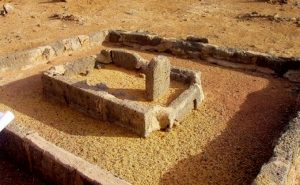 Al-Baqi as viewed by historians
Al-Baqi as viewed by historians
Umar bin Jubair describes al-Baqi as he saw it during his travel to Madina, saying “Al-Baqi is situated to the east of Madina. You enter it through the gate known as the gate of al-Baqi. As you enter, the first grave you see on your left is that of Safiya, the Prophet’s aunt, and further still is the grave of Malik bin Anas, the Imam of Madina. On his grave is raised a small dome. In front of it is the grave of Ibrahim son of our Prophet (s) with a white dome over it, and next to it on the right is the grave of Abdul-Rahman son of Umar bin al-Khattab, popularly known as Abu Shahma, whose father had kept punishing him till death overtook him. Facing it are the graves of Aqeel bin Abi Talib and Abdullah bin Ja’far al-Tayyar. There, facing those graves is a small shrine containing the graves of the Prophet’s wives, following by a shrine of Abbas bin Abdul Muttalib.
After a century and a half, the famous traveller Ibn-e-Battuta came to describe al-Baqi in a way which does not in any way differ from the description given by Ibn Jubair. He adds saying, “At al-Baqi are the graves of numerous Muhajirin and Ansar and many companions of the Prophet (s), except that most of their names are unknown.”
Thus, over the centuries, al-Baqi remained a sacred site with renovations being carried out as and when needed till the Wahhabis rose to power in the early nineteenth century. The latter desecrated the tombs and demonstrated disrespect to the martyrs and the companions of the Prophet (s) buried there. Muslims who disagreed with them were branded as “infidels” and were subsequently killed.
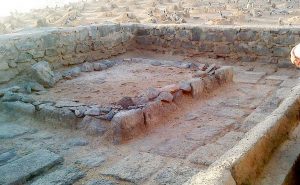 The First Destruction of Al-Baqi
The First Destruction of Al-Baqi
The Wahhabis believed that visiting the graves and the shrines of the Prophets, the Imams or the saints was a form of idolatry and totally un-Islamic. Those who did not conform with their belief were killed and their property was confiscated. Since their first invasion of Iraq, and till nowadays, in fact, the Wahhabis, as well as other rulers of the Gulf States, have been carrying out massacres from which no Muslim who disagreed with them was spared. Obviously, the rest of the Islamic World viewed those graves with deep reverence. Had it not been so, the two caliphs Abu Bakr and Umar would not have expressed their desire for burial near the grave of the Prophet (s).
From 1205 AH to 1217 AH, the Wahhabis made several attempts to gain a foothold in Hijaz but failed. Finally, in 1217 AH, they somehow emerged victorious in Taif where they spilled the innocent blood of Muslims. In 1218 AH, they entered Makkah and destroyed all sacred places and domes there, including the one which served as a canopy over the well of Zamzam.
In 1221, the Wahhabis entered Madina to desecrate al-Baqi as well as every mosque they came across. An attempt was even made to demolish the Prophet’s tomb, but for one reason or another, the idea was abandoned. In subsequent years, Muslims from Iraq, Syria, and Egypt were refused entry into Makkah for Hajj. King Al-Saud set a pre-condition that those who wished to perform the pilgrimage would have to accept Wahhabism or else be branded as non-Muslims, becoming ineligible for entry into the Haram.
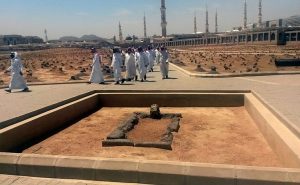 Al-Baqi was razed to the ground, with no sign of any grave or tomb whatsoever. But the Saudis were still not quite satisfied with doing all of that. Their king ordered three black attendants at the Prophet’s shrine to show him where the treasure of valuable gifts were stored. The Wahhabis plundered the treasure for their own use.
Al-Baqi was razed to the ground, with no sign of any grave or tomb whatsoever. But the Saudis were still not quite satisfied with doing all of that. Their king ordered three black attendants at the Prophet’s shrine to show him where the treasure of valuable gifts were stored. The Wahhabis plundered the treasure for their own use.
Thousands of Muslims fled Makkah and Madina in a bid to save their lives and escape from the mounting pressure and persecution at the hands of the Wahhabis. Muslims from all over the world denounced this Saudi savagery and exhorted the Caliphate of the Ottoman Empire to save the sacred shrines from total destruction. Then, as it is known, Muhammad Ali Basha attacked Hijaz and, with the support of local tribes, managed to restore law and order in Madina and Makkah, dislodging the Al-Saud clansmen. The entire Muslim world celebrated this victory with great fanfare and rejoicing. In Cairo, the celebrations continued for five days. No doubt, the joy was due to the fact that pilgrims were once more allowed freely to go for Hajj, and the sacred shrines were once again restored.
In 1818 AD, the Ottoman Caliph Abdul Majid and his successors, Caliphs Abdul Hamid and Mohammed, carried out the reconstruction of all sacred places, restoring the Islamic heritage at all important sites. In 1848 and 1860 AD, further renovations were made at the expense of nearly seven hundred thousand pounds, most of which came from the donations collected at the Prophet’s tomb.
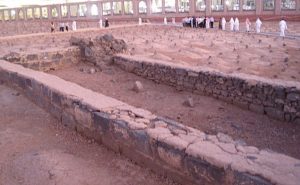 The second plunder by the Wahhabis
The second plunder by the Wahhabis
The Ottoman Empire had added to the splendour of Madina and Makkah by building religious structures of great beauty and architectural value. Richard Burton, who visited the holy shrines in 1853 AD disguised as an Afghan Muslim and adopting the Muslim name Abdullah, speaks of Madina boasting 55 mosques and holy shrines. Another English adventurer who visited Madina in 1877-1878 AD describes it as a small beautiful city resembling Istanbul. He writes about its white walls, golden slender minarets and green fields.
1924 AD Wahhabis entered Hijaz for a second time and carried out another merciless plunder and massacre. People in the streets were killed. Houses were razed to the ground. Women and children too were not spared.
Awn bin Hashim (Sharif of Makkah) writes: “Before me, a valley appeared to have been paved with corpses, dried blood staining everywhere all around. There was hardly a tree which didn’t have one or two dead bodies near its roots.”
1925 Madina surrendered to the Wahhabi onslaught. All Islamic heritage were destroyed. The only shrine that remained intact was that of the Holy Prophet (s).
Ibn Jabhan says: “We know that the tomb standing on the Prophet’s grave is against our principles, and to have his grave in a mosque is an abominable sin.”
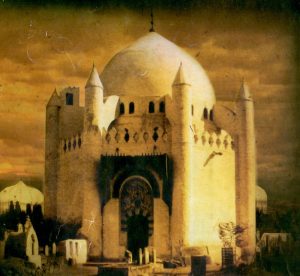 Tombs of Hamza and other martyrs were demolished at Uhud. The Prophet’s mosque was bombarded. On protest by Muslims, assurances were given by Ibn Saud that it will be restored but the promise was never fulfilled. A promise was given that Hijaz will have an Islamic multinational government. This was also abandoned.
Tombs of Hamza and other martyrs were demolished at Uhud. The Prophet’s mosque was bombarded. On protest by Muslims, assurances were given by Ibn Saud that it will be restored but the promise was never fulfilled. A promise was given that Hijaz will have an Islamic multinational government. This was also abandoned.
1925 AD Jannat al-Mu’alla, the sacred cemetery at Makkah was destroyed along with the house where the Holy Prophet (s) was born. Since then, this day is a day of mourning for all Muslims.
Is it not strange that the Wahhabis find it offensive to have the tombs, shrines and other places of importance preserved, while the remains of their Saudi kings are being guarded at the expense of millions of dollars?
Protest from Indian Muslims
1926, protest gatherings were held by shocked Muslims all over the world. Resolutions were passed and a statement outlining the crimes perpetrated by Wahhabis was issued and included the following:
The destruction and desecration of the holy places i.e. the birthplace of the Holy Prophet [s], the graves of Banu Hashim in Makkah and in Jannat al-Baqi (Madinah), the refusal of the Wahhabis to allow Muslims to recite Ziyarah or Surah al-Fatiha at those graves.
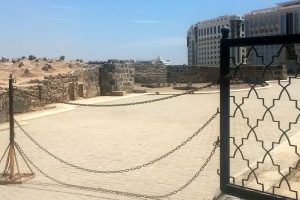 The destruction of the places of worship i.e. Masjid Hamza, Masjid Abu Rasheed, in addition to the tombs of Imams and Sahaba (Prophet’s companions).
The destruction of the places of worship i.e. Masjid Hamza, Masjid Abu Rasheed, in addition to the tombs of Imams and Sahaba (Prophet’s companions).
Interference in the performance of Hajj rituals.
Forcing the Muslims to follow the Wahhabis innovations and to abandon their own ways according to the guidance of the Imams they follow.
The massacre of sayyids in Taif, Madina, Ahsa, and Qatif.
The demolition of the grave of the Imams at al-Baqi which deeply offended and grieved all Shias.
Protest from other countries
Similar protests were lodged by Muslims in Iran, Iraq, Egypt, Indonesia, and Turkey. All of them condemn the Saudi Wahhabis for their barbaric acts. Some scholars wrote tracts and books to tell the world the fact that what was happening in Hijaz was actually a conspiracy plotted by the Jews against Islam, under the guise of Tawheed. The idea was to eradicate the Islamic legacy and heritage and to systematically remove all its vestiges so that in the days to come, Muslims will have no affiliation with their religious history.
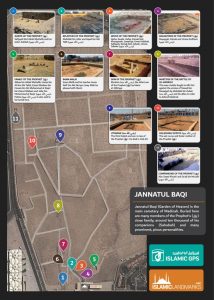 A partial list of the demolished graves and shrines
A partial list of the demolished graves and shrines
Al-Mualla graveyard in Makkah which includes the grave of Sayyida Khadija bint Khuwailid (AS), wife of the Prophet (s), the grave of Amina bint Wahab, mother of the Prophet (s), the grave of Abu Talib, father of Imam Ali (AS), and the grave of Abdul Muttalib, grandfather of the Prophet (SAWW)
The Grave of Hawa (Eve) in Jeddah
The Grave of the father of the Prophet (s) in Madina
The house of sorrows (Bayt al-Ahzan) of Sayyida Fatima (AS) in Madina
The Salman al-Farsi (AS) mosque in Madina
The Raj’at ash-Shams mosque in Madina
The house of the Prophet (s) in Madina, where he lived after migrating from Makkah
The house of Imam Jaffar al-Sadiq (AS) in Madina
The complex (mahalla) of Banu Hashim in Madina
The house of Imam Ali (a) where Imam Hassan (AS) and Imam Husayn (a) were born
The house of Hamza and the graves of the martyrs of Uhud (AS).
 Pressmediaofindia
Pressmediaofindia
